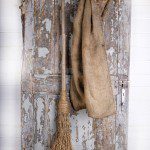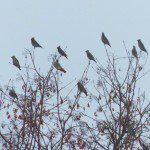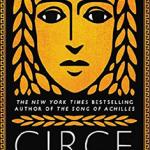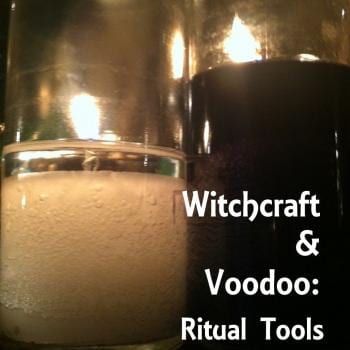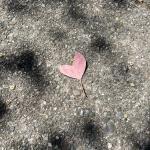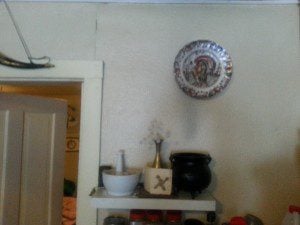
I am a Flamekeeper. I keep a sacred flame for the Goddess Brighid, also known as Brid, as part of a worldwide sisterhood called the Daughters of the Flame. I’ve been a part of the order off and on for almost twenty years now, I think. We burn a candle for twenty-four hours in a rotating nineteen day cycle; my shift starts every nineteen days at 6 pm; which co-ordinates with women all over the world.
We come from all walks of life. We are writers, businesswomen, mechanics, artists and housewives. We are spread over every continent save Africa and Antarctica. Our youngest members are in their twenties; we are proud to include many wise and beautiful Crones. We are straight and lesbian and everything in between.
Some of us are Christian and some are Pagans. Our Christians are Catholic, Orthodox and Mormon. Our Pagans are witches, Druids, Wiccans and Voodoo practitioners. Many of us are Spiritual (no religion). We can be all of these things because Brighid is a Pagan goddess, a Christian saint, and a Voodoo lwa.

The Celts knew Brighid as one of the Tuatha de Danann; daughter of the Dagda, wife of the Fomorian Bres and mother of Ruadan; Her mourning of Her son’s loss in battle gave us the art of keening. She kindles fire in the head; She is a poet, artist, craftswoman and smith. She is a goddess of medicine and healing, of sacred wells and of livestock. So She is a goddess of fire and water, of iron and healing, and of the power of creation as well as the hearth. She was sometimes syncretized with the British/Continental Minerva-esque Brigantia, goddess of “high” things, such as high fires, hill forts, excellence in the arts and smithing, wisdom, intelligence, and sovereignty. She was reputed to be a Druidess and a seeress.
It is said that Imbolc was Her festival day but all we can say for sure is that She was associated with the early arrival of spring. The truth is that we don’t really know much more than that. Jason Mankey wrote an excellent article about what we can say for certain about Her last year. Some of the symbols associated with Her include cauldrons, fire, wells, and a smith’s hammer.
I do a lot of things that Brighid the Celt would appreciate; or perhaps She’s the one who inspires them. I make art. I craft. I write poetry, prose and music. I have even done smithing work and I have trained to fight with a sword. I am also an herbalist and I do healing work. I am also a would-be mother who lost her child in the womb. I can see why She might want to reach out to me. There’s a lot that we share. Brighid is a goddess, but Her pains are human ones.
Imbolc Invocation by Sable Aradia

In Christian times, nuns at the shrine of Kildare (“Church of the Oak,”) which was Brighid’s holy well in Ireland, maintained a sacred flame in the same nineteen day cycle that we Daughters have consciously patterned; though it is said that this was a custom they continued from Celtic Pagan women who preceded them. Irish Catholics to this day continue to honour Her as St. Brigid of Kildare. They still celebrate Her festival as St. Brigid’s Day, which is conflated somewhat with Candlemas; and at Kildare, a perpetual flame is still kept lit.
Every year at Imbolc, we Flamekeepers are sent a wick that was lit from the Kildare flame with which to relight our own candles; most of us then relight our next candle from the flame of the last. I keep my candle in a cauldron literally on my hearth, just above my stove in my kitchen. That’s it in the picture at the top left. I think partially as a consequence, the kitchen is the room in the house we spend the most time living in. In this way I honour Her as both a goddess and a saint.
St. Brigid is said to have chosen the life of a nun over the marriage that Her father (or guardian) chose for Her, and She was so generous that She gave away many of Her things (and Her parents’ things) to beggars, including Her mother’s entire store of butter and Her father’s bejeweled sword. According to some tales She was born into slavery and this last deed showed the king (to whom She gave the sword when he needed it) Her holiness, and he granted Her freedom. She was called “Mary of the Gaels” and, among other deeds, was said to have been Jesus’ wetnurse.

It is said that Brigid Herself founded the Church of the Oak at the perpetual flame and sacred well of the Pagan goddess. The link to the oak speaks to Her Pagan links to Druidry. Due to a tradition that She is said to have begun, the monastery has been co-ruled by an abbot and an abbess for centuries. She was also said to have founded the Kildare Scriptorium which produced the Book of Kildare, considered among the greats of illuminated manuscripts.
As with all saints, Brigid performed several miracles. Most of them relate to protecting women, connecting lovers, healing, and feeding the poor, as well as preserving Her own chastity. She was said to be able to multiply such things as butter, bacon and milk; to bestow cattle and sheep; and to be able to control the weather. Her sacred mantle was said to to heal those who are wrapped in it, and She could expand it to as large as She willed or hang it on a sunbeam. Her skull is interred as a relic at the right of the high altar of Kildare Cathedral. Her symbols include the colour white, oak trees, the winflower, the Madonna lily, a crozier, and the lamp of learning and wisdom.
Of course I’m not remotely this holy, and chastity is hardly one of my virtues, but here I feel a connection also; the protection of women and of the poor concerns me, as does preserving my calling to my faith over and above any other calling; healing and feeding people; and writing and preserving knowledge.

St. Brigid’s Day is also celebrated on February 2nd (by those Voodoo Houses who acknowledge Her) as the fete of Maman Brigitte, who is the wife of the Baron Samedi and who watches over those transitioning from life to death; women in particular. The first grave of a woman in a cemetery is to be consecrated to Her in Haitian Voodoo and She watches over all graves properly marked with a cross. Sometimes She also intercedes with Her Husband when He wants to take someone to the grave early; and She might also sway luck in one’s favour when gambling. If you leave a piece of clothing out on the eve of Her fete She will confer Her blessing upon it. In New Orleans Voodoo She was said to be one of the matron deities of Marie Laveau.
Maman Brigitte was brought over to the New World by indentured Irish servants, and this is how She became part of the lwa. I suppose that is why She is often portrayed as a Caucasian redhead. But She’s also the reason, I have recently learned, for skeletons in bridal gowns and sugar skulls with flowers, hearts and crosses on them; like the one pictured above.
I have just recently come to know this aspect of Brigitte a little. Lilith Dorsey wrote a great article about Maman Brigitte last year and it taught me a good deal about what I currently know about Her as a lwa. She bears only a thin resemblance to the chaste and quietly graceful saint; She can be loud and vulgar like Her Husband, and is reputed not to suffer fools. Her ritual involves a beautiful symbolic death rite that beseeches Her to comfort and care for the dead, and to reunite us with our loved ones (pictured above; it’s amazing what you can find on YouTube!) Her colours are white and purple. She likes pepper-infused rum, chocolate, coffee, oranges, beets and black roosters.

I suppose I’m a little like Maman Brigitte too. I can be blunt, and vulgar, and impatient with foolishness; I love the rich and zesty things of life (especially coffee!) and I don’t flinch much from the skulls beneath the skin we all wear either. I didn’t realize it for some time but She was reaching out to me in this aspect also; for example, unaware of the connection, I found that ceramic sugar-skull pictured above at The Broom Closet Witchcraft Supplies in Regina when I was on my book tour; fell in love with it, and took it home. I wonder if that association comes from Irish memories of Her relic? And I wonder if the tale of St. Brigid’s mantle is how we got the custom of blessed clothing? I am looking forward to incorporating some Voodoo elements into my traditional Imbolc practice.
Brighid was said to be a Celtic Triple Goddess. Sometimes this is interpreted to represent three sisters; one of which was a poet and musician, one of which was a warrior, and one of which was a Druid and healer. Certainly if She never was this, in our modern world, now She is again: Goddess, saint and lwa.
This year I am holding a Wiccan ritual for Brighid in the afternoon of January 31st. We will probably make some Brighid’s crosses, which is a Brigidine folk custom said to go back to Pagan times (though we only know for sure back as far as the sixteenth century.) Another folk custom is to make a “Brid’s Bed,” which is to put a corn dolly in bed with a phallic symbol (I used a Periaptic wand; the picture is above,) and this symbolizes the return of the land’s fertility. Then on the first of February I’ve been asked to give a talk to the local UU congregation as part of my friend’s Brigidine service. On the second I will privately relight my sacred flame and maybe do something to acknowledge Maman Brigitte as well. At the very least, I can make an offering of coffee and peppered rum (both of which I also enjoy!) And maybe some beet salad too. In this way I will celebrate three days of Brighid; again as Goddess, saint and lwa.
Brid is welcome! O, Brid has come! Brid is welcome! Welcome Brid!
Christopher Scott Thompson has kept a marvelous column about Brigidine Paganism over at the Agora blog called “Loop of Brighid” since January of 2013. And the founder of my order, Mael Brigide, keeps a blog called “Brigit’s Sparkling Flame.”


